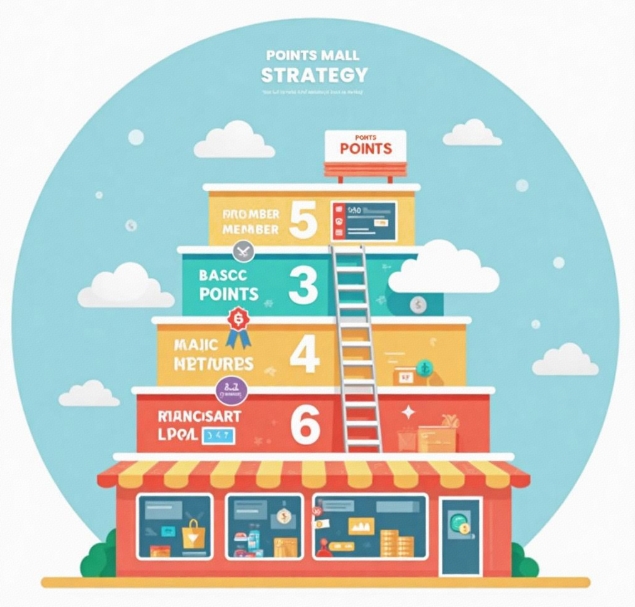How to design the points earning and spending logic for a points mall?
- latest articles
- 1.DApp Development & Customization: Merging Diverse Market Needs with User Experience 2.Analysis of the Core Technical System in DApp Project Development 3.How to achieve cross-chain interoperability in Web3 projects? 4.How does the tokenization of points reconstruct the e-commerce ecosystem? 5.How to Set and Track Data Metrics for a Points Mall? 6.What is DApp Development? Core Concepts and Technical Analysis 7.Inventory of commonly used Web3 development tools and usage tips 8.Development of a Distribution System Integrated with Social E-commerce 9.Six Key Steps for Businesses to Build a Points Mall System 10.What is DApp Development? A Comprehensive Guide from Concept to Implementation
- Popular Articles
- 1.Future Trends and Technology Predictions for APP Development in 2025 2.Analysis of the DeFi Ecosystem: How Developers Can Participate in Decentralized Finance Innovation 3.From Zero to One: How PI Mall Revolutionizes the Traditional E-commerce Model 4.DAPP Development | Best Practices for Professional Customization and Rapid Launch 5.Recommended by the Web3 developer community: the most noteworthy forums and resources 6.How to Develop a Successful Douyin Mini Program: Technical Architecture and Best Practices 7.From Cloud Computing to Computing Power Leasing: Building a Flexible and Scalable Computing Resource Platform 8.Shared Bike System APP: The Convenient Choice in the Era of Smart Travel 9.How to Create a Successful Dating App: From Needs Analysis to User Experience Design 10.From Design to Development: The Complete Process of Bringing an APP Idea to Life
With the rapid development of e-commerce on the internet, point systems have gradually become a core component of platform and brand operations, serving as a crucial means to enhance user engagement, promote consumption, and boost brand loyalty. The points mall is an essential part of this point system, helping businesses build deeper relationships with users through the logical design of point acquisition and redemption. This article will explore how to design the logic for earning and spending points in a points mall to ensure its efficient operation, improve user experience, and achieve the platform's business goals.
I. Basic Concepts of a Points Mall
A points mall, as the name suggests, is a platform that promotes user participation through a point system. Users earn points through consumption, check-ins, activities, etc., and can redeem these points for goods or services. In a points mall, points serve not only as a measure of user activity and loyalty but also as a tool for businesses to attract users and increase repurchase rates. Designing a reasonable logic for earning and spending points can effectively enhance the mall's operational efficiency and improve the user experience.
II. Logic Design for Earning Points
Earning points is a core aspect of a points mall. Reasonable methods for earning points can not only increase user participation but also enhance users' reliance on and loyalty to the platform. Here are several common ways to earn points:
1. Consumption-Based Point Earning
The most common way to earn points is by granting points based on the user's spending amount. This method is intuitive and easy to understand, encouraging users to make purchases. When designing this, consider the following:
Spending Amount to Points Ratio: The exchange ratio between spending amount and points should be reasonable. For example, 1 yuan equals 1 point, or different point multipliers can be designed based on product categories. For high-value items, increasing the number of points earned can attract users to purchase.
Tiered Rewards: To encourage users to spend more, a tiered point reward mechanism can be designed. For instance, spending 100 yuan grants 100 points, spending 500 yuan grants 500 points, and higher spending amounts can reward even more points. Alternatively, a VIP membership tier can be established where users earn more points when their spending reaches specific thresholds.
Purchase Rebate Points: In addition to earning points directly from spending, purchase rebate points can be set up in conjunction with promotional activities. For example, when users purchase certain items, they not only earn points for the item itself but also receive additional rebate points.
2. Task-Driven Point Earning
Earning points by completing tasks can effectively enhance user activity and engagement. Common task types include:
Check-in Tasks: Users can earn a certain number of points by checking in daily. Check-in tasks not only encourage users to stay active but also help cultivate good usage habits through daily reminders.
Social Sharing Tasks: Encourage users to share mall products or activities on social platforms. Upon successful sharing, users receive point rewards. This not only increases platform exposure but also brings more potential customers to the mall.
Review and Feedback Tasks: Encourage users to leave reviews after purchasing products and provide feedback on the platform. Positive reviews and feedback can improve the mall's service quality, and users earn point rewards for their contributions.
3. Activity-Driven Point Earning
Attract user participation by setting up specific activities where users earn points upon completion. Activity-based point earning not only boosts user engagement but also enhances platform sales and activity. Common activity formats include:
Limited-Time Promotions: The platform regularly holds limited-time promotional events where users can earn extra point rewards for purchases made during the event period. This method can spark a buying frenzy in a short time.
Holiday Events: On holidays or special occasions, the platform can organize dedicated holiday activities where users earn higher point rewards for holiday shopping, further stimulating consumption.
Lotteries and Challenge Tasks: For example, users can earn point rewards by completing a challenge task or winning in a lottery event. Through challenging tasks and lottery mechanisms, users can enjoy the fun while increasing their motivation to earn points.
4. Inviting Friends to Register and Make Purchases
When users invite friends to register and make their first purchase, both the inviter and the invitee can be rewarded with points. This method effectively attracts new users to the platform while increasing the activity of existing users through the reward mechanism.
III. Logic Design for Spending Points
Spending points is another critical aspect of points mall design. A reasonable point spending mechanism can enhance user engagement and purchase desire while preventing point abuse or devaluation. Here are several common ways to spend points:
1. Product Redemption
Product redemption is the most straightforward way to spend points, allowing users to exchange points for their favorite products. When designing this, consider the following:
Setting Redemption Thresholds: To prevent point devaluation, set certain point thresholds for product redemption. High-value items require more points to redeem, while low-value items have lower point redemption standards.
Point Discounts: In addition to directly redeeming products with points, set up a method for using points to offset cash. For example, users can use a certain number of points to deduct part of the product price. This increases the flexibility of points and incentivizes users to make purchases.
Redemption Events: Regularly hold limited-time point redemption events, offering specific items available only for point redemption. This can attract user activity within the points mall and increase product sales.
2. Service Redemption
In addition to physical goods, points can also be used to redeem services. For example, users can use points to exchange for membership services, exclusive offers, customized services, etc. This approach enhances the platform's added value and attracts users to purchase non-physical goods.
3. Coupons and Discounts
By redeeming platform coupons with points, users can enjoy discounts when shopping. This method not only attracts users to spend points but also encourages continued consumption on the platform. For example, users can exchange a certain number of points for a coupon, which can be used to deduct cash or receive a discount on their next purchase.
4. Premium Memberships and Privileges
The platform can design a system where points are linked to membership levels. Users can upgrade to premium members by accumulating a certain number of points, enjoying more exclusive privileges. For example, VIP members may receive higher point rebate ratios, dedicated customer service, priority purchasing rights, etc. This approach not only increases user loyalty but also promotes user consumption.
5. Donations or Charity Redemption
In some cases, the platform can design a point donation feature, allowing users to donate their points to charitable organizations or exchange them for participation in charity events partnered with the platform. This approach enhances the platform's social responsibility and strengthens users' sense of social identity.
IV. Considerations for Points Mall Design
1. Point Fairness
To avoid user dissatisfaction, the mall must ensure fairness when designing point earning and spending rules. The processes for earning and spending points should be transparent and just, without setting excessively high thresholds or unreasonable redemption rules, to prevent negative user sentiment due to unclear or overly complex regulations.
2. Preventing Point Abuse
Points mall design should strengthen point management to prevent abuse. For example, implement point expiration mechanisms, set point validity periods to avoid indefinite point accumulation, and use monitoring systems to prevent malicious point farming, ensuring the fairness and reasonableness of points.
3. User Experience
The process of earning and spending points should be simple and clear, avoiding complex rules that confuse users. When designing the interface, focus on user-friendliness, ensuring users can easily view their point balance, earning methods, and spending options, thereby enhancing user engagement and satisfaction.
V. Conclusion
Designing a reasonable logic for earning and spending points in a points mall requires balancing the platform's business goals with the user experience. Through a scientifically designed point system, user activity and loyalty can be effectively promoted, while the platform's marketing objectives are achieved. As market competition intensifies, businesses should continuously optimize and innovate the logic of their points mall based on their product characteristics and user needs to better serve users and drive business growth.
-

How does the tokenization of points reconstruct the e-commerce ecosystem?
With the continuous advancement of internet technology and the gradual prolifera···
-

How to Set and Track Data Metrics for a Points Mall?
With the rapid development of the e-commerce industry, points malls, as a common···
-

Development of a Distribution System Integrated with Social E-commerce
With the rapid development of internet technology, the e-commerce industry has e···

 Blockchain
Blockchain












